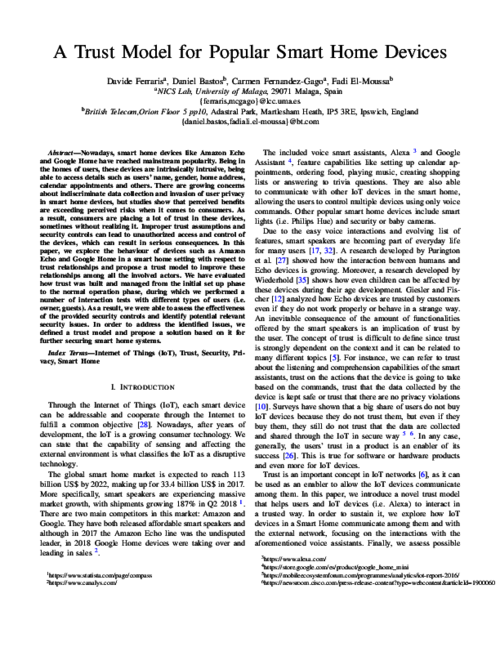 ] Type Year
] Type Year The 20th World Conference on Information Security Applications: WISA-Workshop 2019, Springer, 2019.
Abstract
In recent times, smart home devices like Amazon Echo and Google Home have reached mainstream popularity. These devices are intrinsically intrusive, being able to access user’s personal information. There are growing concerns about indiscriminate data collection and invasion of user privacy in smart home devices. Improper trust assumptions and security controls can lead to unauthorized access of the devices, which can have severe consequences (i.e. safety risks). In this paper, we analysed the behaviour of smart home devices with respect to trust relationships. We set up a smart home environment to evaluate how trust is built and managed. Then, we performed a number of interaction tests with different types of users (i.e. owner, guests). As a result, we were able to assess the effectiveness of the provided security controls and identify some relevant security issues. To address them, we defined a trust model and proposed a solution based on it for securing smart home devices.

International Journal of Information Security, Springer, 2020. DOI
Abstract
Nowadays, smart home devices like Amazon Echo and Google Home have reached mainstream popularity.
Being in the homes of users, these devices are intrinsically intrusive, being able to access details such as users' name, gender, home address, calendar appointments and others.
There are growing concerns about indiscriminate data collection and invasion of user privacy in smart home devices, but studies show that perceived benefits are exceeding perceived risks when it comes to consumers.
As a result, consumers are placing a lot of trust in these devices, sometimes without realizing it.
Improper trust assumptions and security controls can lead to unauthorized access and control of the devices, which can result in serious consequences.
In this paper, we explore the behaviour of devices such as Amazon Echo and Google Home in a smart home setting with respect to trust relationships and propose a trust model to improve these relationships among all the involved actors.
We have evaluated how trust was built and managed from the initial set up phase to the normal operation phase, during which we performed a number of interaction tests with different types of users (i.e. owner, guests).
As a result, we were able to assess the effectiveness of the provided security controls and identify potential relevant security issues. In order to address the identified issues, we defined a trust model and propose a solution based on it for further securing smart home systems.
